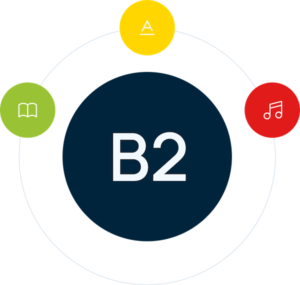English language levels (CEFR)
Tracktest English Test uses the popular CEFR standard (Common European Framework of Reference for Languages) for evaluation. The six reference English levels (A1, A2, B1, B2, C1, C2) are widely accepted as the global standard for grading an individual’s language proficiency.
CEFR English levels are used by all modern English language books and English language schools. It is recommended to use these CEFR levels of English proficiency in job resumes (curriculum vitae, CV, Europass CV) and other English level references. We list here the CEFR descriptors for language proficiency level, their meaning, and approximate equivalents to other global English evaluation schemes- Cambridge ESOL, Canadian Language Benchmarks / Canadian English Language Proficiency Index Program (CLB/CELPIP), Canadian Academic English Language Assessment (CAEL), BULATS, IELTS, and TOEFL.
Frequent questions about the Common European Framework, such as “What is the most required CEFR level?” or “Which is fluent and which is a native-speaker level?“ are answered in our CEFR test FAQs.
Identify your level of English
with our free adaptive English placement test
English Basic User (A1-A2)
A1 English level (Beginner)
Can understand and use familiar everyday expressions and very basic phrases aimed at the satisfaction of needs of a concrete type. Can introduce themselves and others and can ask and answer questions about personal details such as where someone lives, people they know and things they have. Can interact in a simple way provided the other person talks slowly and clearly and is prepared to help.
Start the English beginner test A1Similar to Cambridge BULATS score 10-19, Young Learners English (YLE) Movers.
A2 English level (Elementary English)
Can understand sentences and frequently used expressions related to areas of most immediate relevance (e.g. very basic personal and family information, shopping, local geography, employment). Can communicate in simple and routine tasks requiring a simple and direct exchange of information on familiar and routine matters. Can describe in simple terms aspects of their background, immediate environment and matters in areas of immediate need.
Start the elementary English test A2Similar to Cambridge KEY (KET) certificate, BULATS score 20-39, CLB/CELPIP 4, YLE Flyers.
English Independent User (B1-B2)
B1 English level (Intermediate English)
Can understand the main points of clear standard input on familiar matters regularly encountered in work, school, leisure, etc. Can deal with most situations likely to arise whilst travelling in an area where the language is spoken. Can produce simple connected text on topics, which are familiar, or of personal interest. Can describe experiences and events, dreams, hopes & ambitions and briefly give reasons and explanations for opinions and plans.
Start the intermediate English test B1Similar to Cambridge Preliminary (PET), BEC Preliminary, CLB/CELPIP 5, CAEL 50, IELTS level 4, Duolingo English Test score 60-95, English TOEFL score 57-86.
B2 English level (Upper-Intermediate English)
Can understand the main ideas of complex text on both concrete and abstract topics, including technical discussions in their field of specialisation. Can interact with a degree of fluency and spontaneity that makes regular interaction with native speakers quite possible without strain for either party. Can produce clear, detailed text on a wide range of subjects and explain a viewpoint on a topical issue giving the advantages and disadvantages of various options.
Start the upper-intermediate English test B2The most demanded English test level. Similar to Cambridge First Certificate- English FCE certificate, BEC Vantage, BULATS score 60-74, CLB/CELPIP 6-7, CAEL 60, Duolingo English Test score 100-125, IELTS levels 5-6, TOEFL 87-109.
Proficient English User (C1, C2)
C1 English level (Advanced English)
Can understand a wide range of demanding, longer texts, and recognise implicit meaning. Can express themself fluently and spontaneously without much obvious searching for expressions. Can use language flexibly and effectively for social, academic and professional purposes. Can produce clear, well-structured, detailed text on complex subjects, showing controlled use of organisational patterns, connectors and cohesive devices.
Start the advanced English test C1Similar to Cambridge Advanced (CAE), BEC Higher, CLB/CELPIP 8-9, CAEL 70, Duolingo English Test score (DET) 130-150, IELTS level 7, TOEFL 110-120, TOEIC score 880.
C2 English level (Proficiency)
Can understand with ease virtually everything heard or read. Can summarise information from different spoken and written sources, reconstructing arguments and accounts in a coherent presentation. Can express themself spontaneously, very fluently and precisely, differentiating finer shades of meaning even in more complex situations.
Start the proficiency English test C2Similar to Cambridge English Proficiency (CPE), CLB/CELPIP 10-12, CAEL 80-90, Duolingo English Test score (DET) 155-160, IELTS exam 8-9.
Frequently asked questions about CEFR
There are six levels of language proficiency (A1, A2, B1, B2, C1, C2) according to the CEFR scale. They are grouped into three broader levels: A1-A2 (Basic User), B1-B2 (Independent User), and C1-C2 (Proficient User).
The B2 level is the most demanded level when employers require “active command of the English language”.
It is also a usual requirement for admission to schools, such as the international IB high school programmes, and for entering universities.
It is an alternative naming convention for the CEFR level, where Vantage means B2 level.
Other level names in this convention are: A1- Breakthrough, A2- Waystage, B1- Threshold, B2- Vantage, C1- Advanced, C2- Mastery.
C2 (Proficiency) is the top level you can achieve on the CEFR scale.
Level C2 has no relation whatsoever with what is sometimes referred to as the performance of an idealized “native speaker”, or a “well-educated native speaker” or a “near-native speaker”. Level C2 is not intended to imply native-speaker or near native-speaker competence, but it characterizes the degree of precision, appropriateness and ease with the language (for more details, see CEFR Companion Volume 2018, p.35).
Fluency (i.e., speaking without hesitation and pauses) is only one factor contributing to overall language proficiency. It is a very vague term if used in isolation. In the Tracktest exam, fluency is assessed in the Speaking part of the test or in the Standalone Speaking Test together with accuracy, range, and coherence.
In the CEFR scale, you are expected to have a reasonable degree of fluency at the B1 level, and it should improve higher up. 
